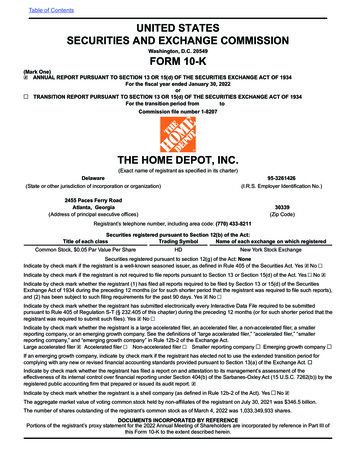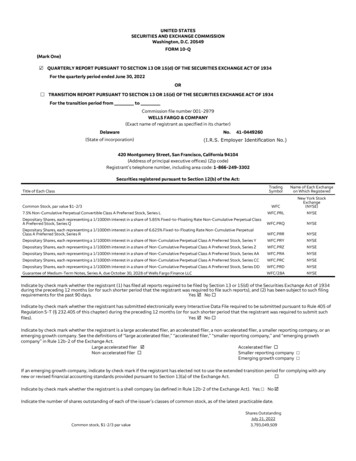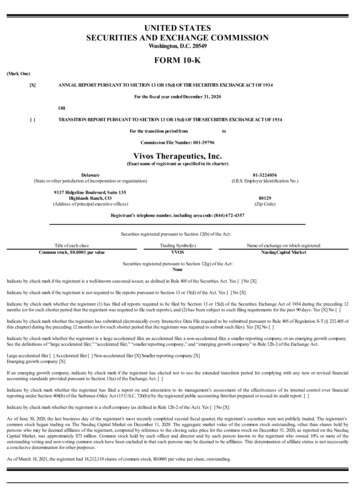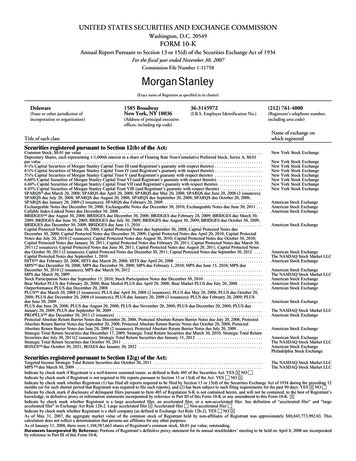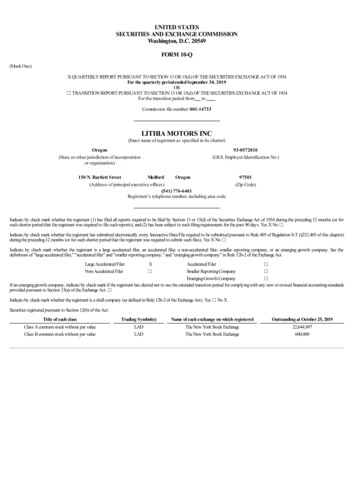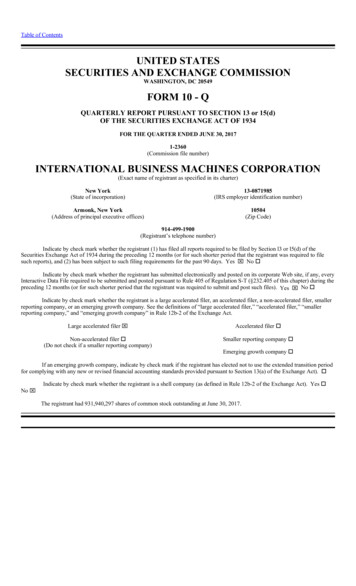
Transcription
Table of ContentsUNITED STATESSECURITIES AND EXCHANGE COMMISSIONWASHINGTON, DC 20549FORM 10 - QQUARTERLY REPORT PURSUANT TO SECTION 13 or 15(d)OF THE SECURITIES EXCHANGE ACT OF 1934FOR THE QUARTER ENDED JUNE 30, 20171-2360(Commission file number)INTERNATIONAL BUSINESS MACHINES CORPORATION(Exact name of registrant as specified in its charter)New York(State of incorporation)13-0871985(IRS employer identification number)Armonk, New York(Address of principal executive offices)10504(Zip Code)914-499-1900(Registrant’s telephone number)Indicate by check mark whether the registrant (1) has filed all reports required to be filed by Section l3 or l5(d) of theSecurities Exchange Act of 1934 during the preceding 12 months (or for such shorter period that the registrant was required to filesuch reports), and (2) has been subject to such filing requirements for the past 90 days. Yes No Indicate by check mark whether the registrant has submitted electronically and posted on its corporate Web site, if any, everyInteractive Data File required to be submitted and posted pursuant to Rule 405 of Regulation S-T (§232.405 of this chapter) during thepreceding 12 months (or for such shorter period that the registrant was required to submit and post such files). Yes No Indicate by check mark whether the registrant is a large accelerated filer, an accelerated filer, a non-accelerated filer, smallerreporting company, or an emerging growth company. See the definitions of “large accelerated filer,” “accelerated filer,” “smallerreporting company,” and “emerging growth company” in Rule 12b-2 of the Exchange Act.Large accelerated filerAccelerated filer Non-accelerated filer (Do not check if a smaller reporting company)Smaller reporting company Emerging growth company If an emerging growth company, indicate by check mark if the registrant has elected not to use the extended transition periodfor complying with any new or revised financial accounting standards provided pursuant to Section 13(a) of the Exchange Act). Indicate by check mark whether the registrant is a shell company (as defined in Rule 12b-2 of the Exchange Act). Yes NoThe registrant had 931,940,297 shares of common stock outstanding at June 30, 2017.
Table of ContentsIndexPagePart I - Financial Information:Item 1. Consolidated Financial Statements (Unaudited):Consolidated Statement of Earnings for the three and six months ended June 30, 2017 and 20163Consolidated Statement of Comprehensive Income for the three and six months ended June 30, 2017 and 20164Consolidated Statement of Financial Position at June 30, 2017 and December 31, 20165Consolidated Statement of Cash Flows for the six months ended June 30, 2017 and 20167Consolidated Statement of Changes in Equity for the six months ended June 30, 2017 and 20168Notes to Consolidated Financial Statements9Item 2. Management’s Discussion and Analysis of Results of Operations and Financial Condition47Item 4. Controls and Procedures84Part II - Other Information:Item 1. Legal Proceedings84Item 2. Unregistered Sales of Equity Securities and Use of Proceeds and Issuer Repurchases of Equity Securities84Item 5. Other Information85Item 6. Exhibits852
Table of ContentsPart I - Financial InformationItem 1. Consolidated Financial Statements:INTERNATIONAL BUSINESS MACHINES CORPORATIONAND SUBSIDIARY COMPANIESCONSOLIDATED STATEMENT OF EARNINGS(UNAUDITED)Three Months Ended June 30,20172016(Dollars in millions except per share amounts)Revenue:ServicesSalesFinancingTotal revenueCost:ServicesSalesFinancingTotal costGross profitExpense and other (income):Selling, general and administrativeResearch, development and engineeringIntellectual property and custom development incomeOther (income) and expenseInterest expenseTotal expense and other (income)Income from continuing operations before income taxesProvision for/(benefit from) income taxesIncome from continuing operationsLoss from discontinued operations, net of taxNet income 12,5476,32441819,289 8,5231,68428910,4958,794 Earnings/(loss) per share of common stock:Assuming dilution:Continuing operationsDiscontinued operationsTotalBasic:Continuing operationsDiscontinued operationsTotal Weighted-average number of common shares outstanding:(millions)Assuming dilutionBasic 5,1601,484(365)(76)1476,3512,4431112,332 (1)2,331 2.480.002.48 2.490.002.49 (Amounts may not add due to rounding.)(The accompanying notes are an integral part of the financial statements.)31.50 8,6911,58226310,5369,702 939.6934.9Cash dividend per common share13,0186,79242920,238Six Months Ended June 30,201720165,3491,465(365)371676,6533,0495442,505 02,504 2.610.002.61 2.620.002.62 960.5957.4 1.4024,88911,72782737,443 8810,3123,018(810)(104)28312,6993,867(218)4,085 (3)4,082 84.320.004.32 4.350.004.35 943.7938.7 62.4959.5 2.70
Table of ContentsINTERNATIONAL BUSINESS MACHINES CORPORATIONAND SUBSIDIARY COMPANIESCONSOLIDATED STATEMENT OF COMPREHENSIVE INCOME(UNAUDITED)Three Months Ended June 30,20172016(Dollars in millions)Net incomeOther comprehensive income/(loss), before tax:Foreign currency translation adjustmentsNet changes related to available-for-sale securities:Unrealized gains/(losses) arising during the periodReclassification of (gains)/losses to net incomeTotal net changes related to available-for-sale securitiesUnrealized gains/(losses) on cash flow hedges:Unrealized gains/(losses) arising during the periodReclassification of (gains)/losses to net incomeTotal unrealized gains/(losses) on cash flow hedgesRetirement-related benefit plans:Prior service costs/(credits)Net (losses)/gains arising during the periodCurtailments and settlementsAmortization of prior service (credits)/costsAmortization of net (gains)/lossesTotal retirement-related benefit plansOther comprehensive income/(loss), before taxIncome tax (expense)/benefit related to items of othercomprehensive incomeOther comprehensive income/(loss)Total comprehensive income/(loss) 2,331 (38)(Amounts may not add due to rounding.)(The accompanying notes are an integral part of the financial statements.)42,504 (248)403 Six Months Ended June 30,201720161014,082 31,2771,023(3)1,2085,290 (21)1,0025,520885202,852 (223)3942,899
Table of ContentsINTERNATIONAL BUSINESS MACHINES CORPORATIONAND SUBSIDIARY COMPANIESCONSOLIDATED STATEMENT OF FINANCIAL POSITION(UNAUDITED)ASSETSAt June 30,2017(Dollars in millions)Assets:Current assets:Cash and cash equivalentsMarketable securitiesNotes and accounts receivable - trade (net of allowances of 304 in 2017 and 290 in 2016)Short-term financing receivables (net of allowances of 272 in 2017 and 337 in 2016)Other accounts receivable (net of allowances of 38 in 2017 and 48 in 2016)Inventories, at lower of average cost or market:Finished goodsWork in process and raw materialsTotal inventoriesPrepaid expenses and other current assetsTotal current assetsProperty, plant and equipmentLess: Accumulated depreciationProperty, plant and equipment — netLong-term financing receivables (net of allowances of 122 in 2017 and 101 in 2016)Prepaid pension assetsDeferred taxesGoodwillIntangible assets — netInvestments and sundry assetsTotal assets(Amounts may not add due to rounding.)(The accompanying notes are an integral part of the financial statements.)5 495At December 31,2016 ,470
Table of ContentsINTERNATIONAL BUSINESS MACHINES CORPORATIONAND SUBSIDIARY COMPANIESCONSOLIDATED STATEMENT OF FINANCIAL POSITION — (CONTINUED)(UNAUDITED)LIABILITIES AND EQUITYAt June 30,2017(Dollars in millions)Liabilities:Current liabilities:TaxesShort-term debtAccounts payableCompensation and benefitsDeferred incomeOther accrued expenses and liabilitiesTotal current liabilitiesLong-term debtRetirement and nonpension postretirement benefit obligationsDeferred incomeOther liabilitiesTotal liabilitiesEquity:IBM stockholders’ equity:Common stock, par value 0.20 per share, and additional paid-in capitalShares authorized: 4,687,500,000Shares issued: 2017 - 2,228,061,8512016 - 2,225,116,815Retained earningsTreasury stock - at costShares: 2017 - 1,296,121,5552016 - 1,279,249,412Accumulated other comprehensive income/(loss)Total IBM stockholders’ equityNoncontrolling interestsTotal equityTotal liabilities and equity(Amounts may not add due to rounding.)(The accompanying notes are an integral part of the financial statements.)6 ,6177,437101,951At December 31,2016 (159,050)(28,189)18,41912518,544120,495 (29,398)18,24614618,392117,470
Table of ContentsINTERNATIONAL BUSINESS MACHINES CORPORATIONAND SUBSIDIARY COMPANIESCONSOLIDATED STATEMENT OF CASH FLOWS(UNAUDITED)Six Months Ended June 30,20172016(Dollars in millions)Cash flows from operating activities:Net incomeAdjustments to reconcile net income to cash provided by operating activitiesDepreciationAmortization of intangiblesStock-based compensationNet (gain)/loss on asset sales and otherChanges in operating assets and liabilities, net of acquisitions/divestituresNet cash provided by operating activities 4,082 1,439777265747857,4214,5181,3827452611671,915* **8,988* **Cash flows from investing activities:Payments for property, plant and equipmentProceeds from disposition of property, plant and equipmentInvestment in softwareAcquisition of businesses, net of cash acquiredDivestitures of businesses, net of cash transferredNon-operating finance receivables — netPurchases of marketable securities and other investmentsProceeds from disposition of marketable securities and other investmentsNet cash used in investing 38)*Cash flows from financing activities:Proceeds from new debtPayments to settle debtShort-term borrowings/(repayments) less than 90 days — netCommon stock repurchasesCommon stock repurchases for tax withholdingsCommon stock transactions — otherCash dividends paidNet cash used in financing )**Effect of exchange rate changes on cash and cash equivalentsNet change in cash and cash equivalents5473,870Cash and cash equivalents at January 1Cash and cash equivalents at June 30 * Revised classification of certain financing receivables.** Reclassified to reflect adoption of the FASB guidance on share-based compensation.(Amounts may not add due to rounding.)(The accompanying notes are an integral part of the financial statements.)77,82611,6961142,330 7,68610,017
Table of ContentsINTERNATIONAL BUSINESS MACHINES CORPORATIONAND SUBSIDIARY COMPANIESCONSOLIDATED STATEMENT OF CHANGES IN EQUITY(UNAUDITED)CommonStock andAdditionalPaid-inCapital(Dollars in millions)Equity - January 1, 2017Cumulative effect of change inaccounting principle * TreasuryStock152,759 (159,050) Total IBMStockholders’Equity(29,398) 102Net incomeOther comprehensive income/(loss)Total comprehensive income/(loss)Cash dividends paid — commonstockCommon stock issued underemployee plans (2,945,036shares)Purchases (920,968 shares) andsales (347,939 shares) of treasurystock under employee plans —netOther treasury shares purchased, notretired (16,299,114 shares)Changes in noncontrolling interests Equity - June 30, 20174,0821,208 (2,724)1554,235 Net incomeOther comprehensive income/(loss)Total comprehensive income/(loss)Cash dividends paid — commonstockCommon stock issued underemployee plans (2,867,128shares)Purchases (769,837 shares) andsales (323,578 shares) of treasurystock under employee plans —netOther treasury shares purchased, notretired (12,305,377 shares)Changes in other equityChanges in noncontrolling interestsEquity - June 30, 2016 53,262 1021024,0821,2085,2904,0821,2085,290 (2,724)(88)(88)(2,708)(2,708)TreasuryStock(28,189) AccumulatedOtherComprehensiveIncome/(Loss)146,124 (155,518) 18,419 Total IBMStockholders’Equity(21)125 NonControllingInterests(29,607) 14,262 1,0024,5181,0025,520(2,590)321162 14,424 709)(16)(1,709)(16)(6)15,8892148,071 (157,298) (28,604) 15,733 * Reflects the adoption of the FASB guidance on intra-entity transfers of assets in the first-quarter 2017.(Amounts may not add due to rounding.)(The accompanying notes are an integral part of the financial 18,392(103) 53,565 146 3004,518(18)18,246 TotalEquity300154,234 (161,860) ommonStock andAdditionalPaid-inCapital(Dollars in millions)Equity - January 1, 201653,935 e/(Loss)(6)156
Table of ContentsNotes to Consolidated Financial Statements:1. Basis of Presentation: The accompanying Consolidated Financial Statements and footnotes of the International Business MachinesCorporation (IBM or the company) have been prepared in accordance with accounting principles generally accepted in the UnitedStates of America (GAAP). The financial statements and footnotes are unaudited. In the opinion of the company’s management, thesestatements include all adjustments, which are only of a normal recurring nature, necessary to present a fair statement of the company’sresults of operations, financial position and cash flows.The preparation of financial statements in conformity with GAAP requires management to make estimates and assumptions thataffect the amount of assets, liabilities, revenue, costs, expenses and other comprehensive income/(loss) that are reported in theConsolidated Financial Statements and accompanying disclosures. These estimates are based on management’s best knowledge ofcurrent events, historical experience, actions that the company may undertake in the future and on various other assumptions that arebelieved to be reasonable under the circumstances. As a result, actual results may be different from these estimates. Refer to thecompany’s 2016 Annual Report on pages 71 to 74, for a discussion of the company’s critical accounting estimates.The company revised the classification of certain financing receivables for the three and six months ended June 30, 2016,decreasing net cash provided by operating activities and net cash used in investing activities in the amount of 70 million and 212million, respectively, which the company concluded to be immaterial to the periods presented. The twelve-month revision for theperiod ended December 31, 2016 was provided in the company’s 2016 Annual Report on page 26. There was no impact to total GAAPcash flows or free cash flow.In the first quarter of 2017, the company reported a benefit from income taxes of 329 million, and its effective tax rate was (23.1)percent. This was primarily driven by a discrete tax benefit of 582 million from a first-quarter 2017 transaction accounted for underthe new Financial Accounting Standards Board (FASB) guidance related to intra-entity transfers of assets. This benefit was partiallyoffset by a discrete tax charge related to foreign audit activity of 99 million. The company had additional discrete tax benefits of 170 million in second-quarter 2017. For the six months ended June 30, 2017, the company reported a benefit from income taxes of 218 million and its effective tax rate was (5.6) percent. The negative effective tax rate in the comparable period of 2016 was due tothe resolution of a long-standing Japan tax matter in February 2016. Refer to note 2, “Accounting Changes,” and the Taxes section ofthe Management Discussion for additional information.Noncontrolling interest amounts of 3.5 million and 3.0 million, net of tax, for the three months ended June 30, 2017 and 2016,respectively, and 7.1 million and 4.4 million, net of tax, for the six months ended June 30, 2017 and 2016, respectively, are includedas a reduction within other (income) and expense in the Consolidated Statement of Earnings.Interim results are not necessarily indicative of financial results for a full year. The information included in this Form 10-Q shouldbe read in conjunction with the company’s 2016 Annual Report.Within the financial statements and tables presented, certain columns and rows may not add due to the use of rounded numbers fordisclosure purposes. Percentages presented are calculated from the underlying whole-dollar amounts. Certain prior year amounts havebeen reclassified to conform to the current year presentation. This is annotated where applicable.2. Accounting Changes:New Standards to be ImplementedIn March 2017, the FASB issued guidance that impacts the presentation of net periodic pension and postretirement benefit costs.Under the guidance, the service cost component of net benefit cost will continue to be presented in the same line items as otheremployee compensation costs, unless eligible for capitalization in the Consolidated Statement of Financial Position. The othercomponents of net benefit costs will be presented separately from service cost as non-operating costs in the Consolidated Statement ofEarnings or Notes to the Consolidated Financial Statements. The guidance is effective January 1, 2018 with early adoption permitted.The company will adopt the guidance as of the effective date. The guidance is primarily a change in financial statement presentationand is not expected to have a material impact in the consolidated financial results.In June 2016, the FASB issued guidance for credit impairment based on an expected loss model rather than an incurred lossmodel. The guidance requires the consideration of all available relevant information when estimating expected credit losses, includingpast events, current conditions and forecasts and their implications for expected credit losses. The guidance9
Table of ContentsNotes to Consolidated Financial Statements — (continued)is effective January 1, 2020 with a one year early adoption permitted. The company is evaluating the impact of the new guidance.In February 2016, the FASB issued guidance which changes the accounting for leases. The guidance requires lessees to recognizeright-of-use assets and lease liabilities for most leases in the Consolidated Statement of Financial Position. The guidance makes somechanges to lessor accounting, including the elimination of the use of third-party residual value guarantee insurance in the capital leasetest, and overall aligns with the new revenue recognition guidance. The guidance also requires qualitative and quantitative disclosuresto assess the amount, timing and uncertainty of cash flows arising from leases. The guidance is effective January 1, 2019 and earlyadoption is permitted. The company will adopt the guidance as of the effective date. A cross-functional implementation team has beenestablished which is evaluating the lease portfolio, system, process and policy change requirements. The company is currentlyevaluating the impact of the new guidance on its consolidated financial results and expects it will have a material impact on theConsolidated Statement of Financial Position. The company’s operating lease commitments were 6.9 billion at December 31, 2016.In 2016, the use of third-party residual value guarantee insurance resulted in the company recognizing 220 million of sales-type leaserevenue that would otherwise have been recognized over the lease period as operating lease revenue.In January 2016, the FASB issued guidance which addresses aspects of recognition, measurement, presentation and disclosure offinancial instruments. Certain equity investments will be measured at fair value with changes recognized in net income. Theamendment also simplifies the impairment test of equity investments that lack readily determinable fair value. The guidance iseffective January 1, 2018 and early adoption is not permitted except for limited provisions. The guidance is not expected to have amaterial impact in the consolidated financial results.The FASB issued guidance on the recognition of revenue from contracts with customers in May 2014 with amendments in 2015and 2016. Revenue recognition will depict the transfer of promised goods or services to customers in an amount that reflects theconsideration to which the entity expects to be entitled in exchange for those goods or services. The guidance also requires disclosuresregarding the nature, amount, timing and uncertainty of revenue and cash flows arising from contracts with customers. The guidancepermits two methods of adoption: retrospectively to each prior reporting period presented, or retrospectively with the cumulativeeffect of initially applying the guidance recognized at the date of initial application (the cumulative catch-up transition method). Thecompany will adopt the guidance on January 1, 2018 and apply the cumulative catch-up transition method. The transition adjustmentto be recorded to stockholders’ equity upon adoption of the new standard is not expected to be material.Given the scope of work required to implement the recognition and disclosure requirements under the new standard, the companybegan its assessment process in 2014 and has since made significant progress, including identification of changes to policy, processes,systems and controls. This also includes the assessment of data availability and presentation necessary to meet the additionaldisclosure requirements of the guidance in the Notes to the Consolidated Financial Statements.The company expects revenue recognition for its broad portfolio of hardware, software and services offerings to remain largelyunchanged. However, the guidance is expected to change the timing of revenue recognition in certain areas, including accounting forcertain software licenses. These impacts are not expected to be material. The company expects to continue to recognize revenue forterm license (recurring license charge) software arrangements on a monthly basis over the period that the client is entitled to use thelicense due to the contractual terms in these arrangements.Since the company currently expenses sales commissions as incurred, the requirement in the new standard to capitalize certain inscope sales commissions will result in an accounting change for the company. However, the impact to the consolidated financialstatements is not expected to be material, with no impact to cash flows.The company continues to assess all potential impacts of the guidance and given normal ongoing business dynamics, preliminaryconclusions are subject to change.Standards ImplementedIn January 2017, the FASB issued guidance which clarifies the definition of a business. The guidance provides a more robustframework to use in determining when a set of assets and activities acquired or sold is a business. The guidance is effective January 1,2018 and early adoption is permitted. The company adopted the guidance effective January 1, 2017, and it did not have a materialimpact in the consolidated financial results.10
Table of ContentsNotes to Consolidated Financial Statements — (continued)In October 2016, the FASB issued guidance which requires an entity to recognize the income tax consequences of intra-entitytransfers of assets, other than inventory, at the time of transfer. Assets within the scope of the guidance include intellectual propertyand property, plant and equipment. The guidance is effective January 1, 2018 and early adoption is permitted. The company adoptedthe guidance on January 1, 2017 using the required modified retrospective method. At adoption, 95 million and 47 million werereclassified from investments and sundry assets and prepaid expenses and other current assets, respectively into retained earnings.Additionally, net deferred taxes of 244 million were established in deferred taxes in the Consolidated Statement of FinancialPosition, resulting in a cumulative-effect net credit to retained earnings of 102 million. In January 2017, the company had onetransaction that generated a 582 million benefit to income tax expense, income from continuing operations and net income and abenefit to both basic and diluted earnings per share of 0.62 per share for the six months ended June 30, 2017. There was no impact inthe consolidated financial results for the three months ended June 30, 2017. The ongoing impact of this guidance will be dependent onany transaction that is within its scope.In March 2016, the FASB issued guidance which changes the accounting for share-based payment transactions, including theincome tax consequences, classification of awards as either equity or liabilities and classification in the Consolidated Statement ofCash Flows. The guidance was effective and adopted by the company on January 1, 2017, and it did not have a material impact in theConsolidated Statement of Financial Position. The ongoing impact of the guidance could result in increased volatility in the provisionfor income taxes and earnings per share in the Consolidated Statement of Earnings, depending on the company’s share price atexercise or vesting of share-based awards compared to grant date, however these impacts are not expected to be material. Theseimpacts are recorded on a prospective basis. See note 5, “Stock-Based Compensation,” for additional information. The companycontinues to estimate forfeitures in conjunction with measuring stock-based compensation cost. The guidance also requires cashpayments on behalf of employees for shares directly withheld for taxes to be presented as financing outflows in the ConsolidatedStatement of Cash Flows. Prior to adoption, the company reported this activity as an operating cash outflow and as a result, priorperiods have been reclassified as required. The FASB also issued guidance in May 2017, which relates to the accounting formodifications of share-based payment awards. The company adopted the guidance in the second quarter of 2017. The guidance had noimpact in the consolidated financial results.In September 2015, the FASB issued guidance eliminating the requirement that an acquirer in a business combination account fora measurement-period adjustment retrospectively. Instead, an acquirer will recognize a measurement-period adjustment during theperiod in which the amount of the adjustment is determined. In addition, the portion of the amount recorded in current-period earningsby line item that would have been recorded in previous reporting periods if the adjustment to the provisional amounts had beenrecognized as of the acquisition date should be presented separately on the face of the income statement or disclosed in the notes. Theguidance was effective January 1, 2016 on a prospective basis. The guidance did not have a material impact in the consolidatedfinancial results.In May 2015, the FASB issued guidance which removed the requirement to categorize within the fair value hierarchy allinvestments for which fair value is measured using the net asset value per share practical expedient. The amendments also removedthe requirement to make certain disclosures for all investments that are eligible to be measured at fair value using the net asset valueper share practical expedient. Rather, those disclosures are limited to investments for which the entity has elected to measure the fairvalue using that practical expedient. The guidance was effective January 1, 2016. The guidance was a change in disclosure only anddid not have an impact in the consolidated financial results.In April 2015, the FASB issued guidance about whether a cloud computing arrangement includes a software license. If a cloudcomputing arrangement includes a software license, then the customer should account for the software license element of thearrangement consistent with the acquisition of other software licenses. If a cloud computing arrangement does not include a softwarelicense, the customer should account for the arrangement as a services contract. All software licenses recognized under this guidancewill be accounted for consistent with other licenses of intangible assets. The guidance was effective January 1, 2016 and the companyadopted it on a prospective basis. The guidance did not have a material impact in the consolidated financial results.3. Financial Instruments:Fair Value MeasurementsAccounting guidance defines fair value as the price that would be received to sell an asset or paid to transfer a liability in anorderly transaction between market participants at the measurement date. Under this guidance, the company is required to classifycertain assets and liabilities based on the following fair value hierarchy:11
Table of ContentsNotes to Consolidated Financial Statements — (continued)xLevel 1—Quoted prices (unadjusted) in active markets for identical assets or liabilities that can be accessed at themeasurement date;xLevel 2—Inputs other than quoted prices included within Level 1 that are observable for the asset or liability, either directlyor indirectly; andxLevel 3—Unobservable inputs for the asset or liability.The guidance requires the use of observable market data if such data is available without undue cost and effort.When available, the company uses unadjusted quoted market prices in active markets to measure the fair value and classifies suchitems as Level 1. If quoted market prices are not available, fair value is based upon internally developed models that use currentmarket-based or independently sourced market parameters
Notes and accounts receivable - trade (net of allowances of 304 in 2017 and 290 in 2016) 8,401 9,182 Short-term financing receivables (net of allowances of 272 in 2017 and 337 in 2016) 17,563 19,006 Other accounts receivable (net of allowances of 38 in 2017 and 48 in 2016) 994 1,057 Inventories, at lower of average cost or market:
